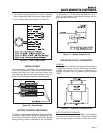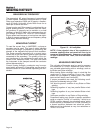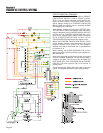
SSeeccttiioonn 33
IINNSSUULLAATTIIOONN RREESSIISSTTAANNCCEE TTEESSTTSS
CCAAUUTTIIOONN!!:: SSoommee ggeenneerraattoorrss mmaayy uussee eeppooxxyy oorr
ppoollyyeesstteerr bbaassee wwiinnddiinngg vvaarrnniisshheess.. UUssee ssoollvveennttss
tthhaatt wwiillll nnoott aattttaacckk ssuucchh mmaatteerriiaallss..
Use a soft brush or cloth to apply the solvent. Be care-
ful to avoid damage to wire or winding insulation. After
cleaning, dry all components thoroughly using mois-
ture-free, low-pressure compressed air.
DDAANNGGEERR!!:: DDOO NNOOTT AATTTTEEMMPPTT TTOO WWOORRKK WWIITTHH
SSOOLLVVEENNTTSS IINN AANNYY EENNCCLLOOSSEEDD AARREEAA.. PPRROO--
VVIIDDEE AADDEEQQUUAATTEE VVEENNTTIILLAATTIIOONN WWHHEENN
WWOORRKKIINNGG WWIITTHH SSOOLLVVEENNTTSS.. WWIITTHHOOUUTT AADDEE--
QQUUAATTEE VVEENNTTIILLAATTIIOONN,, FFIIRREE,, EEXXPPLLOOSSIIOONN OORR
HHEEAALLTTHH HHAAZZAARRDDSS MMAAYY EEXXIISSTT .. WWEEAARR EEYYEE
PPRROOTTEECCTTIIOONN.. WWEEAARR RRUUBBBBEERR GGLLOOVVEESS TTOO
PPRROOTTEECCTT TTHHEE HHAANNDDSS..
CLOTH OR COMPRESSED AIR:
For small parts or when dry dirt is to be removed, a
dry cloth may be satisfactory. Wipe the parts clean,
then use low pressure air at 30 psi (206 Kpa) to blow
dust away.
BRUSHING AND VACUUM CLEANING:
Brushing with a soft bristle brush followed by vacuum
cleaning is a good method of removing dust and dirt.
Use the soft brush to loosen the dirt, then remove it
with the vacuum.
STATOR INSULATION RESISTANCE
GENERAL:
Insulation resistance is a measure of the Integrity of
the insulating materials that separate electrical wind-
ings from the generator's steel core. This resistance
can degrade over time due to the presence of conta-
minants, dust, dirt, grease and especially moisture).
The normal Insulation resistance for generator wind-
ings is on the order of “millions of ohms” or
“megohms”.
When checking the insulation resistance, follow the
tester manufacturer's Instructions carefully. Do NOT
exceed the applied voltages recommended in this
manual. Do NOT apply the voltage longer than one
(1) second.
CCAAUUTTIIOONN!!:: DDOO NNOOTT ccoonnnneecctt tthhee HHii--PPoott TTeesstteerr
oorr MMeeggoohhmmmmeetteerr tteesstt lleeaaddss ttoo aannyy lleeaaddss tthhaatt aarree
rroouutteedd iinnttoo tthhee ggeenneerraattoorr ccoonnttrrooll ppaanneell.. CCoonnnneecctt
tthhee tteesstteerr lleeaaddss ttoo tthhee SSttaattoorr oorr RRoottoorr lleeaaddss oonnllyy..
STATOR SHORT-TO-GROUND TESTS:
See Figure 3-2. To test the Stator for a short-to-
ground condition, proceed as follows:
1. Disconnect and Isolate all Stator leads as follows:
a. Disconnect sensing leads 11S and 22S
from the voltage regulator.
b. Disconnect excitation winding lead No. 6
from the voltage regulator.
c. Disconnect excitation lead No. 2 from the
excitation circuit breaker (CB3).
d. Disconnect battery charge winding leads
No. 66 and 77 from the battery charge recti-
fier (BCR).
e. Disconnect battery charge winding lead No.
55 from the battery charge resistor (R1).
f. At the main circuit breakers, disconnect AC
power leads No. 11P and 33.
g. At the 4-tab ground terminal (GT), discon-
nect Stator power leads No. 22P and 44.
2. When all leads have been disconnected as outlined in Step 1
above, test for a short-to-ground condition as follows:
a. Connect the terminal ends of all Stator
leads together (11S, 22S, 11P, 22P, 33, 44,
2,6, 55, 66, 77).
b. Follow the tester manufacturer's instructions
carefully. Connect the tester leads across
all Stator leads and to frame ground on the
Stator can. Apply a voltage of 1500 volts.
Do NOT apply voltage longer than one (1)
second.
If the test Indicates a breakdown in Insulation, the
Stator should be cleaned, dried and re-tested. If the
winding fails the second test (after cleaning and dry-
ing), replace the Stator assembly.
TEST BETWEEN ISOLATED WINDINGS:
1. Follow the tester manufacturer's instructions carefully. Connect
the tester test leads across Stator leads No. 11P and 2. Apply
a voltage of 1500 volts- DO NOT EXCEED 1 SECOND.
2. Repeat Step 1 with the tester leads connected across the fol-
lowing Stator leads:
a. Across Wires No. 33 and 2.
b. Across Wires No. 11P and 66.
c. Across Wires No. 33 and 66.
d. Across Wires No. 2 and 66.
If a breakdown in the insulation between isolated
windings is indicated, clean and dry the Stator. Then,
repeat the test. If the Stator fails the second test,
replace the Stator assembly.
Page 13


















